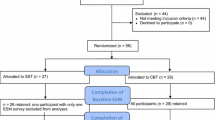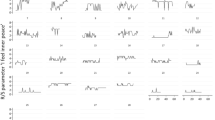Abstract
The Experience Sampling Method (ESM) is a novel assessment strategy that allows random sampling of thoughts, affects, and behaviors. In ESM studies subjects wear beepers that signal at randomly generated, preprogrammed times at which subjects fill out a questionnaire containing items related to current activity, location, thought content, mood states, etc. The ESM was used to examine the relationship between mood states and thought content in a hospitalized sex offender. The patient exhibited a very high frequency of thoughts with sexual content, as well as thoughts indicative of anger against women, personal inadequacy, and distress. He appeared to be a poor judge of his state of optimal well-being. Whereas he considered support from others to be related to optimal well-being, it was actually sexual thoughts about a woman that were associated with his optimal well-being. The present case study illustrates the value of the ESM in the study of complex thought—affect—behavior relationships.
Similar content being viewed by others
References
Crepault, C., and Couture, M. (1980). Men's erotic fantasies.Arch. Sex. Behav. 9: 565–582.
Csikszentmihalyi, M., and Larson, R. W. (1984).Being Adolescent Basic Books, New York.
Csikszentmihalyi, M., Larson, R. W., and Prescott, S. (1977). The ecology of adolescent activities and experience.J. Youth Adolescence 6: 281–294.
Dijkman, C. I. M., and deVries, M. W. (1987). The social ecology of anxiety: Theoretical and quantitative perspectives.J. Nerv. Ment. Dis. 175: 550–557.
Groth, N. (1983). Treatment of the sexual offender in a correctional institution. In Greer, J., and Stuart, I. (eds.),The Sexual Aggressor: Current Perspectives on Treatment Van Nostrand Reinhold, New York.
Hillbrand, M., Foster, H. G., and Hirt, M. (1990). Rapists and child molesters: Psychometric comparisons.Arch. Sex. Behav. 19: 65–71.
Hillbrand, M., and Waite, B. M. (1992a). The social context of anger among violent forensic patients: An analysis via Experience Sampling Method.J. Offender Rehab. 18: 81–89.
Hillbrand, M., and Waite, B. M. (1992b). [Context of Anger: Assessment Scores]. Unpublished raw data.
Hillbrand, M., Waite, B. M., Korn, M. L., and Krystal, J. H. (1992, April). New directions in aggression research: Novel assessment strategies. Symposium at the annual meeting of the Eastern Psychological Association, Boston, MA.
Hormuth, S. E. (1986). The sampling of experiencesin situ.J. of Personality 54, 262–293.
Hurlburt, R. T., and Melancon, S. M. (1987). Single case study: “Goofed-up” images: Thought sampling in a schizophrenic woman.J. Nerv. Ment. Dis. 175: 575–578.
Kubey, R., and Csikszentmihalyi, M. (1990).Television and the quality of life: How viewing shapes everyday experience Erlbaum, Hillsdale, NJ.
Larson, R. W., and Johnson, C. (1985). Bulimia: Disturbed patterns of solitude.Addictive Behav. 10: 281–290.
Larson, R. W., Raffaelli, M., Richards, M. H., Ham, M., and Jewell, L. (1990). Ecology of depression in late childhood and early adolescence: A profile of daily states and activities.J. Abn. Psychol. 99: 92–102.
Marshall, W. L., Jones, R., Ward, T., Johnston, P., and Barbaree, H. E. (1991). Treatment outcome with sex offenders.Clin. Psychol. Rev. 11: 465–485.
Waite, B. M., and Hillbrand, M. (1991, April). The subjective experience of television viewing of college students and forensic patients. Paper presented at the annual meeting of the Eastern Psychological Association, New York.
Author information
Authors and Affiliations
Rights and permissions
About this article
Cite this article
Hillbrand, M., Waite, B.M. The everyday experience of an institutionalized sex offender: An idiographic application of the experience sampling method. Arch Sex Behav 23, 453–463 (1994). https://doi.org/10.1007/BF01541409
Issue Date:
DOI: https://doi.org/10.1007/BF01541409




